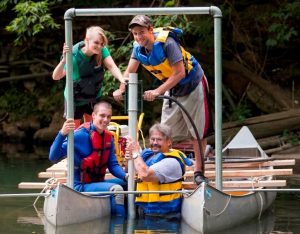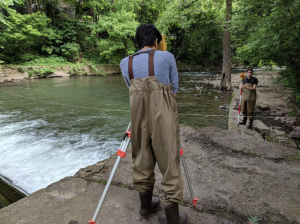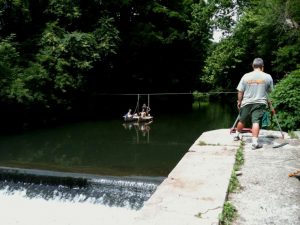The proposed dam removals afford a unique opportunity close to Lafayette College for detailed study of the long-term impacts of dam removal on the stream.
Published Research
Profs Brandes and Germanoski are conducting a long-term study of changes in Bushkill Creek channel morphology, sedimentology, and hydrology before and after dam removal, currently proposed to be completed in 2020. Each year they measure a series of channel cross-profiles upstream and downstream of the first three dams, and collect grain size data at each cross-profile to characterize the channel bed prior to dam removal. Previously they mapped approximately 5.7 km of the creek from its confluence with the Delaware River upstream to Edgewood Avenue. The stream was mapped based on physical characteristics such as runs, riffles, and pools as well as features such as islands, exposed bedrock, rip-rap, bridges, significant storm drainage pipes, and retaining walls. Additionally, Brandes and Germanoski maintain a stream gauge between Dams 2 and 3 and are in the process of installing an additional gauge below Dam 1 in collaboration with Stroud Water Research Center.

Maricate Conlon ’11 (clockwise from left), Tyler Germanoski ’12, Professor Dru Germanoski, and Michael Thompson ’12 work on the Bushkill Creek.
See the “Dynamics of Bushkill Creek after Dam Removal” ArcGIS Story-Map

Students Nouman Naveed and Matt Tascione surveying a cross-section at Dam 3 near the silk mill redevelopment project.
Ecological research by Dr. Rothenberger is examining impacts on biota and sediment at Dam 1 in Easton and two other dams farther upstream. The study involves the collection of over five years of pre-removal monitoring data. The study has found a strong correlation between water quality and macro-invertebrates in this system, implying that removal of the lower three dams would lead to improvements in water quality, biotic integrity, and resilience in the Bushkill Creek.
See Dr. Rothenberger’s published paper: “A risk assessment study of water quality, biota, and legacy sediment prior to small dam removal in a tributary to the Delaware River”

Joshua Hitchings ’14, Bradley Ohlinger ’13, and Professor Megan Rothenberger ’02 measure water velocity, pH, dissolved oxygen, and temperature in the Bushkill Creek. Photo by Bill Stank, PhotoSynthesis Photography
Student Research Projects
A student documenttry on the impacts of dams on shad polulation and health of river.
An interdisciplinary collaborative digital humanities project to explore environmental, social, and cultural changes that have occurred over the past century along the Bushkill Creek corridor near Lafayette College.
See “A Century of Change Along the Bushkill” https://sites.lafayette.edu/changingbushkillcreek/
A report from the Lafayette College, Department of Civil & Environmental Engineering provides the necessary base mapping for the continued analysis of the Bushkill Creek low-head dam on Lafayette College owned property near 3rd Street in the city of Easton. It found based on the aforementioned report, that a project utilizing hydropower in this location is neither economically or technically feasible based on currently available technologies.
See “Bushkill Creek Survey Report 3rd Street to the PA Route 22 Overpass”
https://sites.lafayette.edu/bushkillcreekfilm/files/2011/08/Bushkill-Creek-Survey-Report-3rd-St-Dam-Final.pdf

Sediment coring at the 3rd Street Dam.